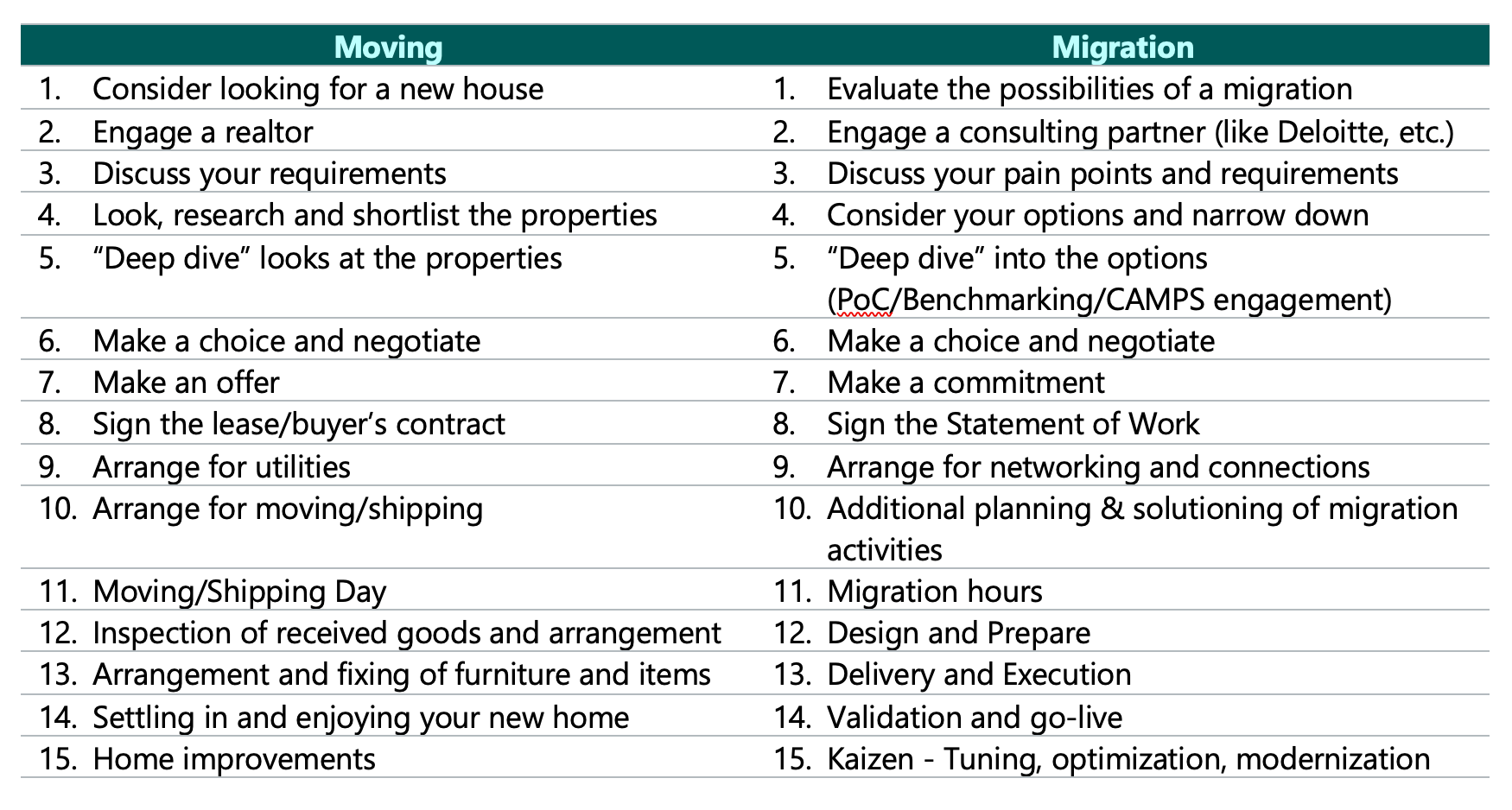Think of any upgrade, migration, or competitive migration, which at Teradata is known as “Sweep,” as if it were a move of your residence, which of course, it is - for your business.
You must sweep before you move into a new house and set up your stuff.
For any move: When you sign a lease or close on a house and get the keys, it’s just the beginning, isn’t it?
You must have the movers you’ve hired get your “stuff” from the old place to the new one – that’s what Teradata Migration Services does. But that’s just part of the story, right?
And if we want to go into further details: truck size, moving in parts (large items first, smaller items later), speed of moving based on the choice of vehicles, moving overseas using a moving coordinator, customs/passports/duties/fees/insurance for the move, etc. This can be viewed as the migration strategy.
The movers must carefully load your furniture for best use of the space and for safety. They must make sure the roads are good— no muddy or washed-out patches, no low clearance underpasses, for example. You must decide on what goes and what doesn’t. Sometimes you want some items to go with you in your car, not the truck. You may even want to take some things early in a separate “seed” move.
Once the movers do their job, they usually don’t unpack or hang your portraits on the wall. They usually assemble and place the big furniture items, provided they were not damaged during the packing, moving, or unpacking. That is data migration and validation.
Next, you must get the utilities turned on – electricity, water/trash, phones, cable/internet, etc. Hopefully all of those happen in short order without a hitch – right? That’s what your Project/Program Manager ensures – or the client must do it themselves. And those are outside of the migration itself, which is where Professional Services takes over.
But if they don’t go without a hitch – say you have some problems with your appliances and you must call a repair person – like the HVAC company. Or say, your Wi-Fi doesn’t cover the whole house and you need someone to help with that. That’s again Professional Services to provide specialized skills such as optimization, performance tuning, data movement, query grid, and security services, etc.
Or if you’re moving from an apartment to a house…that’s a different story completely! You need more furniture, for example, and more setup. Maybe an interior decorator, or maybe a carpenter! These would be again additional Professional Services like Business Continuity, Master Data Management, and other modernizations, etc.
Now, let’s talk about a cloud migration – it’s like moving overseas. It can be daunting and unfamiliar. And if you don’t speak the language, a simple operation can end up being a nightmare, and if you don’t react, then a disaster!
You must hire a logistics company to get your stuff shipped. Arrange for new (bi-directional) banking, taxes, international and local telephone, utilities, and bi-directional shipping (including import and export duties, customs), etc. All of this is more complicated and never as easy as you would expect.
So, you need experts – Cloud Architect Migration Planning Services (CAMPS) – to set the stage, plan, build a manifest, and make sure everything gets there – in one piece preferably. Or you invest in super glue later.
Further, there’s all the networking, private links, bandwidth considerations, other “unforeseen” bugs (remember – Murphy was an optimist). And then of course, there’s the language barrier – each CSP has their own language, each customer has their own escalation and other procedures. And your coordination with Cloud Operations and onboarding is outside of Migration Services. That again is back in the Professional Services court which warrants a Program Manager.
Each customer has their own tools and models too, which is another reason for a PS PM and a full-time Tech Lead – both with Cloud experience, working with the customer to understand their pain-points, and come up with appropriate solutions. And of course, there is modernization and optimization for the new architecture (especially ETL and “chatty” applications), as well as normal performance tuning for a new platform with very different characteristics. The saving grace if you’re a Teradata customer is that Teradata is Teradata – everywhere, so you don’t have to deal with any of THAT.
Another example is moving from a big house to a smaller house and finding that your stuff doesn’t fit. You thought you were going to save money, but now you must rent a storage space – or build an addition, but you didn’t know that going in…
Get the picture?
It’s never as easy as it looks – and it often costs a lot more than you planned – unless you planned well and hired the right people with the right tools and know-how.
We would like to conclude that “Quick and easy” often means sloppy and incomplete, and there are a lot more loose ends. Which means $$$$.
To make it easier to visualize, here is a chronological list of all the moving events and the corresponding migration events.
.png?origin=fd)
 Samuel Sterling
Samuel Sterling
